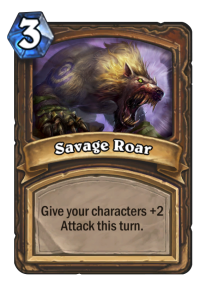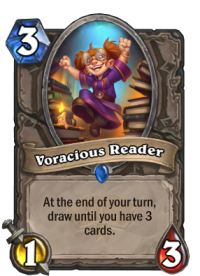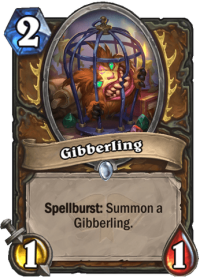Our budget Aggro Token Druid deck list & guide for the Scholomance Academy expansion will teach you how to play this budget list. This guide includes Mulligans, Gameplay Strategy, Card Substitutions, and Combos/Synergies!
Introduction to Budget Aggro Token Druid

I’m calling the deck “Aggro” token Druid to differentiate it from slower Token builds, like Treant-based decks. Token Druid was in and out of the meta for the last few sets, but it was always a slower build. This one is different and plays more like the older, Un’Goro-era Druids. The goal is to flood the board with small minions, and either keep buffing them or just finish the game with Savage Roar. The deck has multiple ways to flood the board early and a great refill in a form of Voracious Reader.
Just like Demon Hunter, it’s basically a full meta build – the archetype is just very cheap and requires no Epics & Legendaries, and that’s great news for budget players. On the other hand, even the full meta deck isn’t particularly powerful right now, but sadly that’s the best Druids have got.
Check out Hearthstone Budget Decks & Guides for All 10 Classes!
Budget Aggro Token Druid Mulligan Guide
Higher Priority (Keep every time)
- Gibberling – Probably the most important card in your deck, you always want to mulligan for it. Paired with a couple of spells, you can summon multiple 1/1’s, possibly even buffing them to 2/2’s right away.
- Other 1-drops – While not as high priority as Gibberling, you still want to open the game with a minion, so you keep cards like Blazing Battlemage or Acornbearer just to have something to play right away.
- Voracious Reader – It’s one of the only decks in which you want to keep Voracious Reader. The reason is that you drop your hand so quickly that having access to a refill is super important. Ideally, if you drop Reader early paired some buff it might survive more than a single turn and you might get more than one round of draws.
Lower Priority (Keep only if certain conditions are met)
- Innervate / Lightning Bloom – Keep depending on the rest of your hand. They’re a good keep with Gibberling (summon more 1/1’s), Intrepid Initiate (trigger its Spellburst) or Voracious Reader (empty your hand quickly to draw more cards).
- Adorable Infestation / Beaming Sidekick – Keep if you already have an actual 1-drop – those cards are bad or even useless by themselves on T1, but pretty good to play on T2 (or Coin out on T1) on a 1-drop.
Budget Aggro Token Druid Play Strategy

Gameplay with this deck is quite simple, but most importantly your games are very quick. For that reason, it’s an interesting choice to grind ladder or finish some related Quests. You blow out your whole hand during the early turns, and then, unless you draw Voracious Reader at the perfect time, you most likely just lose the game if your opponent clears everything. The good news is that you can put A LOT of stats on the board early. For example, Turn 1 Intrepid Initiate + Lightning Bloom + Adorable Infestation + Beaming Sidekick = 4/5 + 1/2 + 1/1 on Turn 1, but you skip your Turn 2 and your hand is empty. So you need that to carry your early game – and often it does. Don’t even try to play it slower, it’s not worth it – early push into Savage Roar finisher is your best bet.
That’s also the reason why Voracious Reader is so important. You run out of cards really quickly, so it’s super easy for Voracious Reader to draw 3 cards. What’s even better is that you run multiple buffs, so e.g. dropping her on the same turn you play Power of the Wild makes her harder to remove. I had some games where a buffed Voracious Reader survived for a couple of turns and carried the game. Without Reader, you rely on topdecks – you might still find the right cards, or you might draw your Innervate/Bloom with empty hand and the game will be over.

However, a card that is nearly as important as Reader is definitely Gibberling. With 18 spells in your deck, including ten 0-1 mana ones, you have multiple ways to clone the card. With the right hand, it creates some really powerful early game board states, especially when going second. Following Giberrling with a few spells can easily create 4-5 1/1’s, and that’s not something most of the decks can clear on T1-T2. It’s even better if you manage to buff them to 2/2 or 3/3 – that’s just game-winning.
And that’s basically how the deck plays. Try to flood the board, buff the board, finish everything with Savage Roar. Try to close out the games around Turn 4-5 if possible, because you have no ways to get through Taunts or deal burn damage from hand (in rare scenarios you might discover something with Nature Studies, but that’s not something you can always count on.
Future Card Replacements for Aggro Token Druid
Actually, there are no clear card replacements. It’s already a fully working deck – no Legendary will make it better. However, there are still a few card choices you might consider. If you’re facing decks with AoE board clears, you can add Cult Neophyte instead of one of your 1-drops. The card can delay e.g. Breath of the Infinite, Consecration or Brawl by one turn. It doesn’t seem like much, but one extra round of attacks is often a difference between winning and losing the game. You can also try to go for a slightly slower route and add Soul of the Forest. The card can be good in the right scenarios, such as the early tempo push into Soul on T4 to make your board sticky. But the problem is that it’s quite expensive and it’s often a dead card in the hand, which is not good for Voracious Reader.















/rating_1_half.png)
/rating_2_off.png)